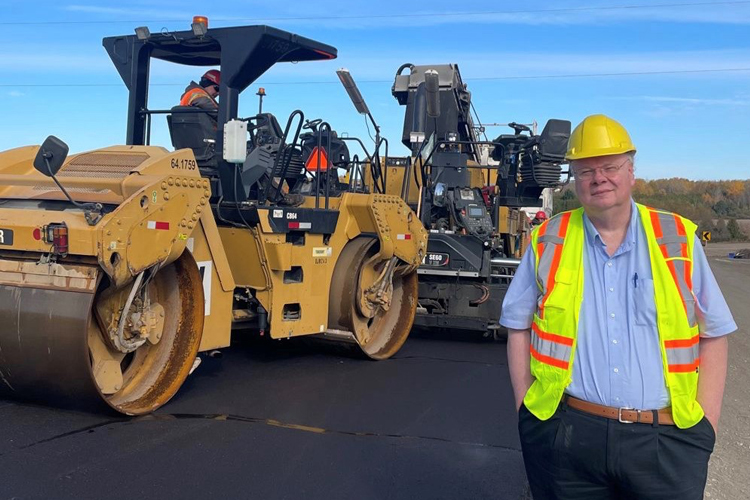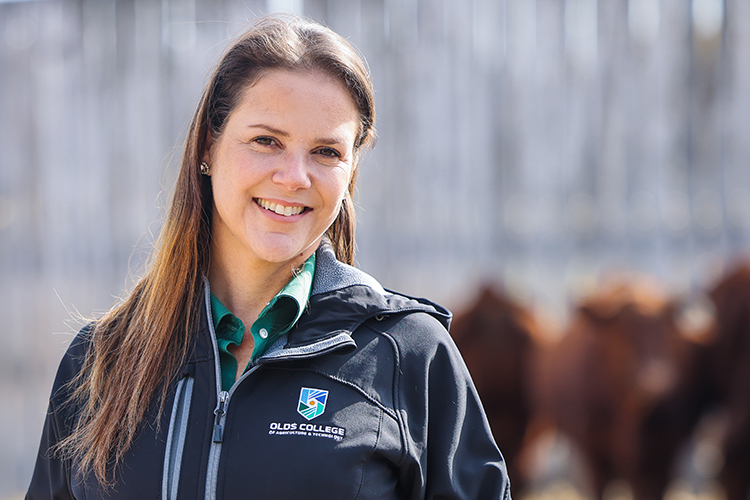Better glue for better roads

Fostering dynamic interaction between discovery and innovative research is essential for research results to be translated into new knowledge, products or processes. The Natural Sciences and Engineering Research Council of Canada (NSERC) supports collaborations among institutions, researchers and industry leaders to accelerate the application of discovery research for social, environmental and economic benefits.
Longtime NSERC-funded researcher Dr. Simon Hesp’s discovery and partnership research has helped establish new test standards for asphalt binders and optimize processes using Alberta oil sands. We connected with Dr. Hesp, Full Professor in the Department of Chemistry at Queen’s University and esteemed expert in asphalt binders, to gain insight into his groundbreaking work, the challenges he faced and the motivations driving his pursuit of discovery.
Dr. Hesp, you started researching asphalt binders more than three decades ago. What prompted you to follow this career path?
I’m from the Netherlands originally and in 1983 I stopped by the University of Toronto (U of T) where I met a professor, the late James Guillet, a polymer chemist. I got my first research experience as an undergraduate student in Professor Guillet’s lab and after a four-month internship, I was hooked on research in polymer chemistry. When I finished my master’s degree, I worked for about a year at a lab at Hitachi in Tokyo, Japan, where I worked on photolithography to “write” on microchips with light.
Eventually, I decided to make a 180-degree turn and see how I could do something good for Canadian society and taxpayers. I joined a chemical engineering research group at U of T to look at polymers and how they can modify the asphalt binder that holds our roads together. I got stuck to this sticky material and I’m still doing it today at Queen’s University. It’s a lot of fun and we’ve had great success over the years.
NSERC has had the privilege of supporting you through several different programs, including our flagship Discovery Grants. What has been the impact of your long-standing Discovery grant on your research program?
Discovery grants are about research. Research is about discovery. Early on in my career, it wasn’t easy to get funding for asphalt research, especially when you’re a young researcher in Kingston, Ontario. NSERC Discovery grants allowed me to conduct free inquiry into the basics of why roads fail, without any link to industry or commercial interests. I wanted to do something to build better roads, and companies sometimes have slightly different objectives. My Discovery grant allowed me the flexibility to look into areas that we don’t necessarily take into account in bigger industrial projects and contracts.
Can you tell us the story of how discovery research has led to the development of better asphalt for Canadian roads?
In my first few years of research, I got things wrong. I was taking a reductionist approach thinking that, if roads crack, we need a tougher material. Asphalt is a fairly complicated system for which you need to do a systems analysis as there are a lot of distress factors that interact with each other. It’s too complicated an issue for just a reductionist approach.
In 2000, I decided to look at some very old pavements around Ontario. I drove my car to Hearst, Petawawa and Bracebridge to gather pavement trial samples, along with other pavement trial samples from Lamont, Alberta. These were pavement test roads with the same design, traffic, climate and thickness, but some were in perfect condition whereas others were falling apart. The only difference was the composition of the asphalt binder, the glue.
In 2009, we serendipitously found that a lot of the asphalt binders were tainted with used motor oil residues. A lubricant cannot mix with an adhesive, so the roads were failing so quickly that it was just unsustainable. To avoid this, we needed sensitive, accurate and precise testing methods that account for traffic and climate so we can select better asphalt. I have worked with the Ontario Ministry of Transportation, lots of municipalities in Ontario and some states in the United States as well, and they’re now adopting some of the tests we developed.
NSERC has also had the privilege of supporting you through partnership research grants. How have you leveraged those partnerships with government and industry partners?
My NSERC partnership grants allowed me to equip my lab to become competitive in the world. The Collaborative Research and Development Grants program was fabulous because it helped me raise money to do all this research and support about 200 students over the years who worked in my lab.
I understand the Alliance program has changed a little, and for the better, because you now match government funding and funding from arm’s length government institutions. That’s a tremendous improvement because my research is mostly attractive to government agencies. Through my career, more than half of the funding has come from NSERC, and it has delivered very useful test methods with the data that we obtained.
Where can we find roads for which the processes that you’ve developed were used?
About 40 kilometers north of Timmins, on highway 655, we have 15 test sections containing recycled polyethylene terephthalate (PET) bottle fibers, and one of them is going to last 40 years. The current standard in Northern Ontario is 15 years of serviceability for asphalt roads. We can do nearly three times better by using that composition.
There is a contract on Princess Street in Kingston, Ontario, where after more than 12 years there are seven blocks that still look brand new today. You can see a dramatic change for the better once better test methods were implemented and material was tested as stated in the road paving contract. In the Durham region in Ontario, we doubled and tripled the lifespan of roads on hundreds of contracts.
There’s a 10-kilometer stretch on the Trans-Canada Highway north of Algonquin Park that was constructed in 2011 and is still pretty much free of cracks. That section could be useable for up to 60-70 years with appropriate recycling.

Text description of figure 1
Two side by side 2023 Google Streetview images of downtown Princess Street in Kingston, Ontario. The image on the left shows a 100 m section reconstructed in 2010 before Dr. Hesp’s better test methods were implemented. The road segment is damaged, with about 50 large visible cracks throughout. The image on the right shows an adjacent section of the same street after Dr. Hesp’s methods were implemented. The road has remained almost free of cracks over 1,000 m for more than 10 years.
Where do you see your research going next?
There’s interesting chemistry in recycling processes. There’s one process called hot in-place recycling where you grind up the pavement, you heat it up and you rejuvenate it. It costs about half as much as regular paving, and it probably lasts longer than the regular paving as it is done today. This is an area where I see my research going next, because there is a tremendous need for it and demand.
We have a few commitments, with some U.S. states, to build demonstration projects using asphalt binder from Alberta later this year and next year, to show that we can use the same methods in the U.S. as we do in Ontario now. We are hoping to double or triple the lifespan of their roads too.
There’s $12 trillion worth of oil sands bitumen in Alberta, and it’s the best crude oil to make the asphalt binder for roads that we will need. Socioeconomic activity in Canada is linked quite a bit to a good transportation network and it would be difficult to find anything else that triples the life of roads. We can confidently say we have had great success. Everyone uses asphalt every day. Hundreds of billions of dollars of goods are transported every day. Asphalt roads are invaluable, and they will be around for as long as there are cars driving on our roads, whether they’re gasoline or electric.
I was recently asked why I am still here doing this. I was the youngest of many siblings, so I learned a few things from my older brothers and sisters, but the one thing my mother taught me is to never give up. Grit is what is needed to succeed in research; you need to be persistent and never give up!
This interview was condensed and edited for length and clarity.
About Dr. Simon Hesp
Dr. Simon Hesp is a Full Professor at the Department of Chemistry at Queen’s University, where he founded the Hesp Research Group. He has worked in partnership with Imperial Oil and the Ontario Ministry of Transportation, amongst many others, for the betterment of the asphalt industry. He has been involved in the design, evaluation and monitoring of more than 50 pavement test sections in Lamont, Petawawa, Cochrane, Hearst and the Ottawa and Greater Toronto areas.
Read more about Dr. Hesp’s research in the article “Lessons learned from 60 years of pavement trials in continental climate regions of Canada” published in the Chemical Engineering Journal.
Up next

Advancing Reproductive Efficiency & Stress Management in Beef Heifers
The primary goal of a cow-calf operation is to produce one calf per cow per year. However, the journey to achieving this reproductive success is fraught with challenges influenced by a variety of factors, including genetics, nutritional status, and stress, each playing a crucial role in the performance of heifers.